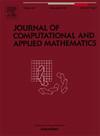On a fractional generalization of a nonlinear model in plasma physics and its numerical resolution via a multi-conservative and efficient scheme
IF 2.1
2区 数学
Q1 MATHEMATICS, APPLIED
Journal of Computational and Applied Mathematics
Pub Date : 2025-01-02
DOI:10.1016/j.cam.2024.116474
引用次数: 0
Abstract
In this work, we extend the Zakharov–Rubenchik system to the fractional case by using Riesz operators of fractional order in space. We prove that the system is capable of preserving extensions of the mass, energy, momentum and two linear functionals. In a second stage, we propose a discretization to approximate the solutions of our model. In the way, we propose discrete forms of the conserved functionals, and we prove that they are also conserved in the discrete domain. We prove that the numerical scheme has second-order accuracy in both space and time. Moreover, we establish theoretically the properties of conditional stability and second-order convergence of the scheme. The numerical model was implemented computationally, and some simulations are provided in order to illustrate that the method is capable of conserving the discrete functionals and its rate of convergence. This is the first report in the literature in which a multi-conservative fractional extension of this system is proposed, and a numerical scheme to approximate its solutions is designed and fully analyzed for conservative and numerical properties. Even in the integer-order case, this is the first article which proves the approximate conservation of the momentum, and which rigorously proves the stability and the convergence of a scheme for the Zakharov–Rubenchik system.
求助全文
约1分钟内获得全文
求助全文
来源期刊
CiteScore
5.40
自引率
4.20%
发文量
437
审稿时长
3.0 months
期刊介绍:
The Journal of Computational and Applied Mathematics publishes original papers of high scientific value in all areas of computational and applied mathematics. The main interest of the Journal is in papers that describe and analyze new computational techniques for solving scientific or engineering problems. Also the improved analysis, including the effectiveness and applicability, of existing methods and algorithms is of importance. The computational efficiency (e.g. the convergence, stability, accuracy, ...) should be proved and illustrated by nontrivial numerical examples. Papers describing only variants of existing methods, without adding significant new computational properties are not of interest.
The audience consists of: applied mathematicians, numerical analysts, computational scientists and engineers.

 求助内容:
求助内容: 应助结果提醒方式:
应助结果提醒方式:


